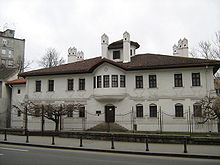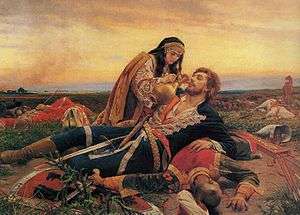Belgrade City Museum
The Belgrade City Museum (Serbian Cyrillic: Музеј Града Београда) is a museum located in Belgrade, Serbia. Founded in 1903, the museum operates with several cultural institutions: Ivo Andrić Museum, Princess Ljubica's Residence, Paja Jovanović Museum, Banjica Concentration Camp Museum, Collection of Icons Sekulić, Archaeological Site Vinča and Jovan Cvijić Museum.
Музеј Града Београда | |
 Countess Ljubica's Residence in 2008 | |

| |
| Established | 1903 |
|---|---|
| Location | Belgrade, Serbia |
| Coordinates | 44.804198°N 20.461199°E |
| Director | Jelena Medaković |
| Website | www |
The Belgrade City Museum contains over 2,500 paintings, graphics, aquarelles and drawings. It contains numerous paintings by Serbian painters Paja Jovanović, Sava Šumanović, Uroš Predić, Nadežda Petrović, Petar Lubarda and others. Among others, it contains paintings and graphics by foreign artists Albrecht Dürer, Miklós Barabás and Jean-Baptiste-Camille Corot.
Collections

The Belgrade City Museum collections are:
- Prehistory
- Antique
- Middle Ages
- Coins and Medals
- Arheogical site Vinca
- History of Belgrade 1521-1941
- History of Belgrade since 1941
- Fine Arts and Music before 1950
- Fine Arts and Music after 1950
- Applied Arts and Ethnology
- Education and Science
- Culture and Literature
- Urban Planning and Architecture
The museum also operates an outpost in, and documenting, the former Banjica concentration camp.
New building
City awarded the former military building at the corner of Resavska ad Nemanjina streets, and the adjoining lot, for the future location of the Belgrade City Museum. Known as the Military Academy Building, it was built in 1899 and designed by Dimitrije T. Leko. It leans on the Building of the General Staff, which was built in 1965. Massive reconstruction and adaptation into the museum, after the project of Jelena Vojvodić, Goran Vojvodić and Jovana Grujevska, was tentatively announced in 2016. Total floor area of the museum will cover 17,000 m2 (180,000 sq ft). Part of the building will be preserved while other parts will be upgraded and modernized. The entry staircase and portal were demolished, in order to make the inner space higher. The inner yard will be restored and the exhibition rooms, depot, conservation area, library, work shops, archaeological lapidarium and amphitheater will be formed. Frontal outer walls, at the corner itself, will be adapted into the media façades.[1][2]
Left wing will be adapted into the permanent exhibition space. Right wing will host administration, library, workshops and conservation sector. Depots will be arranged on each floor and in the entire basement. In 2018 the first phase of the complete reconstruction of the building was announced. In May 2020, works were postponed to 2021.[1][2]
See also
- National Museum of Serbia
- White Palace
External links
References
- Slađana Raner (24 August 2018). "Београд ће добити музеј какав заслужује" [Belgrade will get a museum it deserves]. Politika-Moja kuća (in Serbian). p. 2.
- Daliborka Mučibabić (1 June 2020). "Obnova Muzeja grada sledeće godine" [Renovation of the City Museum next year]. Politika (in Serbian). p. 15.